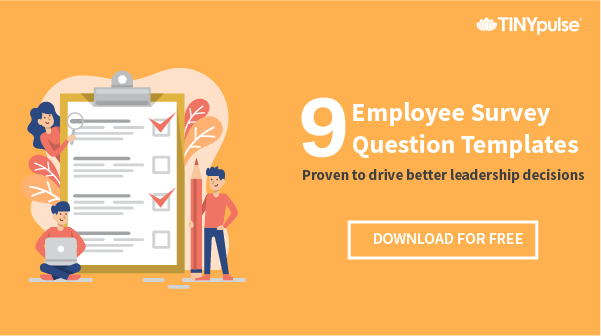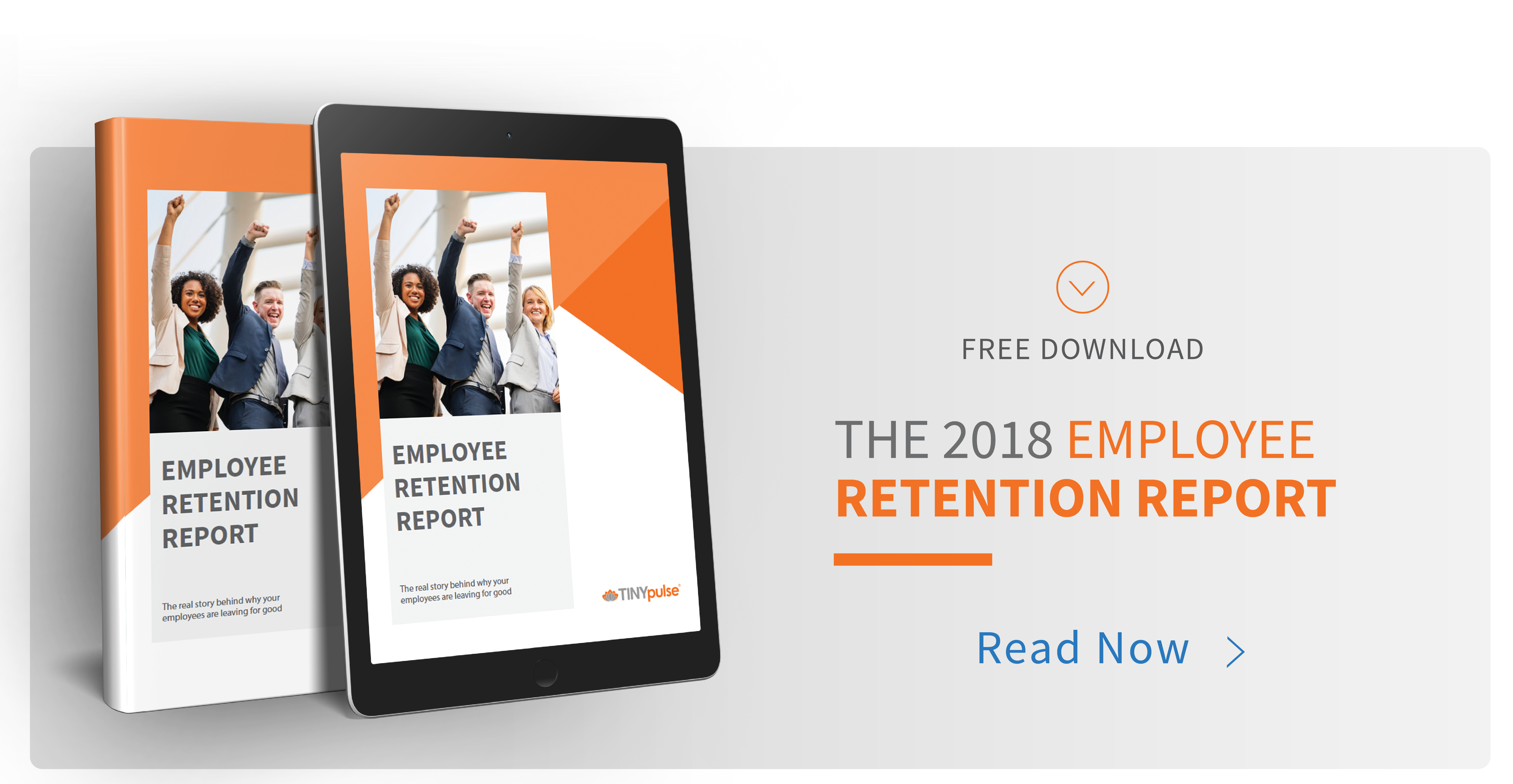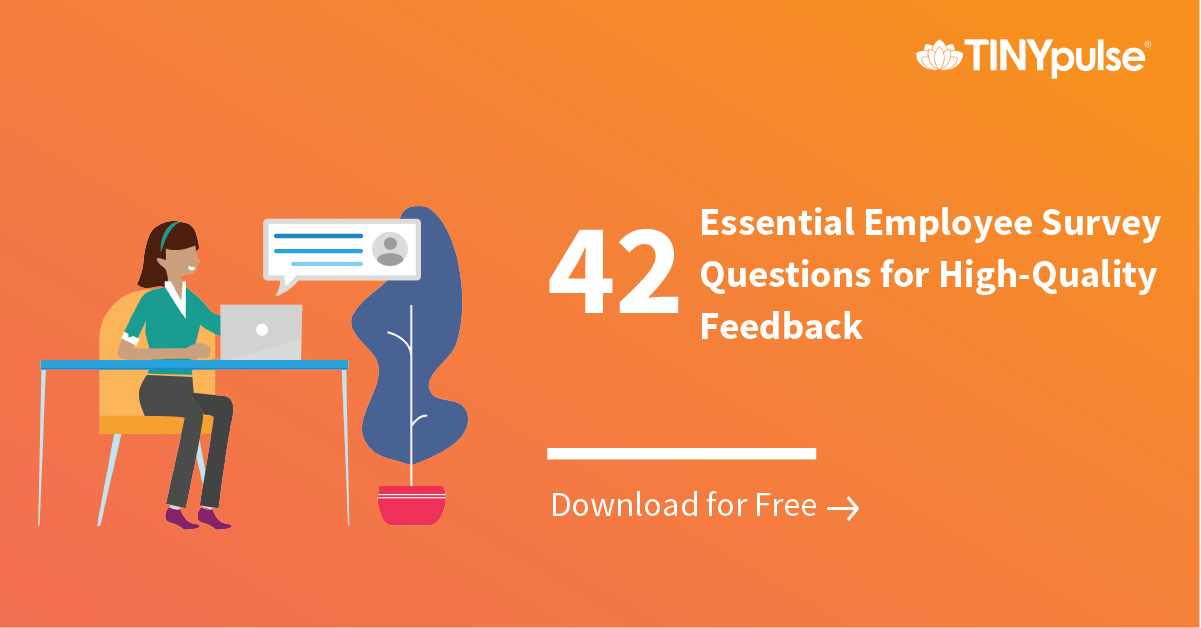17 Essential Survey Questions to Predict Employee Attrition and Turnover
What will our workforce look like when the “new normal” becomes the actual norm?
Like many organizations, you may still be in survival mode just trying to get by. And that’s perfectly fine.
This pandemic has undoubtedly changed the workforce and forced many companies to shift to non-standard work models as a protective, cost-saving measure.
A Gartner analysis found that 32% of organizations are replacing full-time employees with temporary and independent workers — a trend that is likely to continue post-COVID.
Major companies have also recently announced workforce cuts due to increased financial pressure stemming from this economic crisis.
Given our current situation, it’s no wonder many of our employees may be worried about their jobs.
But that doesn’t mean they don’t have options. If your employees don’t feel secure in their jobs, they may be thinking about jumping ship. Here’s how to figure out if that’s going to happen.
Workforce Planning During and After the Pandemic
During times of crisis, you need to ensure you continue to humanize your employees.
Contrary to popular belief, when employees leave, it isn’t always a bad thing—as long as it’s for a good reason. Despite your best attempts, some permanent layoffs or downsizing may be inevitable. Such is life.
Good news: Accurate attrition insights can help you effectively analyze our ever-changing workforce, plan for any necessary organizational restructuring, and prevent layoffs.
Even though you might have to cut back on hours, you still need to develop succession plans for key positions and ensure you retain top-performing employees.
Losing employees you need most can cost you more in the long run. Believe it or not, voluntary turnover costs businesses an estimated $300 billion every year.
By taking a holistic approach to workplace planning and employee retention, you can build employee confidence in your organization and create a stronger, more stable workforce.
What’s the difference between employee attrition and turnover?
Employee attrition and turnover are often used interchangeably. While they are both measurements of employees’ leaving our organizations, there are different reasons employees leave.
What is employee attrition?
When employees leave our organizations, it’s sometimes unpreventable. Employee attrition is the natural employment cycle where life changes or organizational needs prompt them to leave.
Some examples include employees who retire, move, or are laid off. The key with attrition is the organization doesn’t intend to replace employees.
Being able to forecast attrition is especially important given the current global financial crisis we are in. If you know your employees are ready to retire soon or are planning to move to a different area, you may be able to avoid some layoffs by not filling these vacancies as they come up.
When it comes to analyzing and forecasting employee attrition, accurate data is key.
What is employee turnover?
Employee turnover measures employees who leave for another position or are fired. Many times, employee turnover can be prevented with proper planning and communication.
To keep employees with your organization, you need to be able to understand their needs or dissatisfactions in order to make meaningful changes.
Take, for instance, an employee who recently had a baby. She may not want to place her baby in child care and may be thinking of quitting her job altogether.
A parental needs analysis could help you identify programs like allowing infants at work, flex schedules, job sharing, telework, and other options that might prevent her from leaving. This, in turn, helps your company support a diverse workforce.
On the other hand, deciding not to invest in employee retention can have real consequences for your organization.
Employee Survey Template to Predict Attrition & Turnover
An employee survey about attrition and turnover can give you a glimpse of your future workforce.
Knowledge is power. Knowing how many of your employees are thinking about leaving — and why that’s the case — allows you to create strategic retention plans.
Don’t wait until it’s too late. By intervening before your employees leave, you can increase the chances your top performers stick around.
As an added bonus, your survey insights can help you with long-term organizational planning. This means you’ll be able to ensure a smooth transition when key employees retire.
Survey Questions about Employee Organizational Commitment
1. How likely are you to stay at this organization if you were to receive a 10% salary increase from another organization?
1 being very likely to leave, 5 being very likely to stay
2. How enthusiastically would you reapply for a job here?
1 being extremely unenthusiastically, 5 being extremely enthusiastically
3. How likely are you to be working here in one year?
1 being extremely unlikely, 5 being extremely likely
4. How likely would you be to refer someone to work here?
1 being extremely unlikely, 5 being extremely likely
5. How likely would you be to recommend our organization's products or services to a friend or colleague?
1 being not at all likely, 5 being extremely likely
How loyal are your employees?
Employee loyalty is based on a variety of factors, including your organization’s culture. These survey questions are particularly helpful for gauging employee loyalty and predicting turnover.
Higher scores in this category means your employees are more committed to your company and more likely to stay in their position.
If your scores are lower in this area than you’d like, consider following up with an employee engagement survey. This will help you better understand why your employees responded the way they did.
Survey Questions About Employees’ Intention to Leave
6. Have you interviewed for another job in the last three months?
Yes, No
7. Do you intend to be with the organization after 12 months?
Yes, No
8. I have never considered quitting my job to pursue non-work options.
1 being strongly disagree, 5 being strongly agree
9. I am likely to stay with this organization for the next year.
1 being strongly disagree, 5 being strongly agree
10. How likely is it that you will leave the organization in the next 12 months?
1 being very unlikely, 5 being very likely
11. If you were to give notice and leave our organization, what would the primary reason be? ______________
Are you employees about to leave your organization?
Asking your workers about their intentions may seem bold, but it’s crucial to get accurate data.
Your responses to these questions will help you identify your company’s attrition and turnover trends. This will give you a better understanding of why your employees may be leaving.
If your trends indicate that several employees are planning to leave your organization, it’s time to dig deeper.
Take a closer look at your responses to number six and 11. Are your employees interviewing for other jobs? Or are they planning to retire?
Comparing your attrition rates with your turnover rates can help you make data-based decisions. Follow up with your employees to learn what’s driving these results.
Instead of waiting for an exit interview to find out how your employees feel about your organization, take action now.
Simple interventions like periodic stay interviews or conversations can help you make continuous improvements that improve retention across your organization.
Survey Questions about Employees’ Job Alternatives
12. It would be difficult for me to find another job as good as this one.
1 being strongly disagree, 5 being strongly agree
13. I have a low probability of finding an acceptable alternative to my job.
1 being strongly disagree, 5 being strongly agree
14. If you search for an alternative job within a year, what are the chances you can find an acceptable job?
1 being very high chance, 5 being very low chance
15. If you have received a job offer in the past year, to what extent did you consider accepting it?
1 being I almost left, 5 being I didn't consider it
16. If you received a job offer today, to what extent would you consider accepting it?
1 being very high chance, 5 being very low chance
Can your employees easily find a new job?
How easily your employees could find a comparable (or better) job can dramatically affect your turnover rates.
Sacrifice is one of the core elements of job embeddedness. If your employees’ are able to find a new job without sacrificing much in return, they are less likely to be connected to your organization.
This, in turn, decreases their job embeddedness and may increase employee turnover.
If you have low scores in this area, it may be time to consider developing (or updating) an employee retention plan.
To get started with employee retention improvements:
- Discover which factors affect retention in TINYpulse’s employee retention report.
- Send a follow up survey to your employees to learn more about their unique needs.
- Explore and prioritize potential retention interventions.
Survey Question about Employee Job Confidence
17. How secure do you feel in your current role?
1 being not secure at all, 5 being extremely secure
Do you know what your employees’ top COVID-19 concerns are?
TINYpulse found that employees’ top concerns relating to COVID were company impact and job security. If your employees don’t feel secure in their position, they may be more likely to look for a new job.
If your employees are feeling a little insecure in their position, be proactive and transparent. Communication is key to building trust with your team.
Engage in an open dialogue with your employees’ about your situation. Try to provide safe communication channels and ask for feedback often.
How is employee retention at your organization?
During times of crisis, effective workforce planning can help you ensure long-term organizational stability.
An employee attrition and turnover survey can shed a light on how many employees plan to leave your company and why they’re leaving.
These insights can help you make data-driven decisions that prevent layoffs, ensure you have succession plans in place, and retain more of your top employees.
It’s a great way to make sure your business is ready to weather any storms that come its way.
Share this
You May Also Like
These Related Stories







.png?width=534&height=632&name=blog%20ad%20(1).png)
